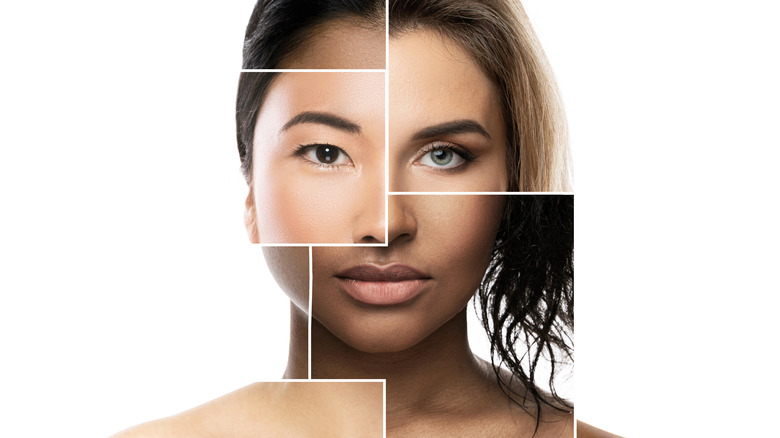When You Should Stop Ignoring Those New Facial Hairs
With events like No Shave November, men's facial hair has become a hot topic over the last decade or so. Different beard styles and care products have spread through popular culture. In fact, for some, a good beard or mustache is necessary before any look is really considered complete. But as men's facial hairstyles have increased, more people are wondering if facial hair really is as abnormal in women as it seems to be common in men.
It turns out that the answer is a little more complicated than a simple yes or no. A close lean-in to any mirror will show tiny hairs all over your face. This is known as vellus hair or peach fuzz and the Cleveland Clinic explains that it both protects our skin and helps us maintain a comfortable body temperature. However, excess vellus hair can indicate a developing condition, like Cushing's Disease. But what, exactly, counts as excess hair?
Determining excess hair is tricky
Many people may have an idea of what an excessive amount of hair looks like. But a mental image may be based on misconceptions because facial hair is measured against something called the Ferriman-Gallwey hirsutism score to determine if it qualifies as excessive, as per a 2018 study published in Advances in Dermatology and Allergology. It debuted in 1961.
Ferriman and Gallwey measured hair thickness, density, and color in numerous places on the female body, then created a scale system that would, in theory, allow for easier diagnosis of conditions like polycystic ovarian syndrome (PCOS).
However, neither scientist took racial differences into account when they created their scale. In fact, a 2014 study published in The Journal of Clinical and Aesthetic Dermatology found that all of the measured hair growth factors changed depending on a patient's race. The testing group for the Ferriman-Gallwey hirsutism score was likely too limited to provide an accurate idea of what overall female hair can look like.
Another study, this time in 2017 published in the International Journal of Trichology, supported this idea. As a result, experts suggested that a new version is needed, one that acknowledges the variety of women's facial hair. And, to prove it, they tried implementing such a scale. But what happens when a woman does have excess facial hair or more facial hair than they had before?
It's all about hormones
The changes in a woman's facial hair are largely due to hormonal changes, otherwise known as changes to her endocrine system. As Cleveland Clinic states, this can occur naturally as a result of aging. A woman's estrogen level drops as she ages, which changes the balance of hormones.
However, experts caution that this is not the only cause of excess hair growth. Hair appearing suddenly or changing, such as darkening, thickening, or growing coarser, over a short period of time can indicate that a woman is affected by hirsutism.
Like age-related changes in hair growth, hirsutism is caused by changes in a woman's hormone levels. More specifically it is caused by an increase in testosterone. Such an increase can also result in additional symptoms, like baldness, increased muscle density, and acne among others (via Mayo Clinic). Other common causes of increased testosterone in women consist of PCOS, tumors, certain medications, and issues in the adrenal glands.
What a doctor can do
A woman who suspects she has hirsutism can request blood tests to measure her hormone levels (per Mayo Clinic). It is a common method for diagnosing such an issue. Further tests may be necessary to specify the cause of the imbalance, which includes pelvic or abdominal exams if the doctor suspects a tumor. Women with conditions like PCOS are often treated with lifestyle changes and medications that can help control any acne development and hair changes, according to Johns Hopkins Medicine.
In the meantime, the usual hair removal methods, such as plucking, waxing, shaving, and tweezing, can remove unwanted hair temporarily (via Mayo Clinic). And women who want to remove their "excess" hair certainly aren't alone. A study published in the Journal of the American Academy of Dermatology dating as far back as 1992 has documented the psychological effects of hirsutism and the distress it can cause, such as depression.
On the flip side of, a woman does not have to remove any hair growth that she feels comfortable with. On the contrary, if there's no reason to seek medical attention, women and men have the liberty to flaunt or leave the remainder of their hair as is.




